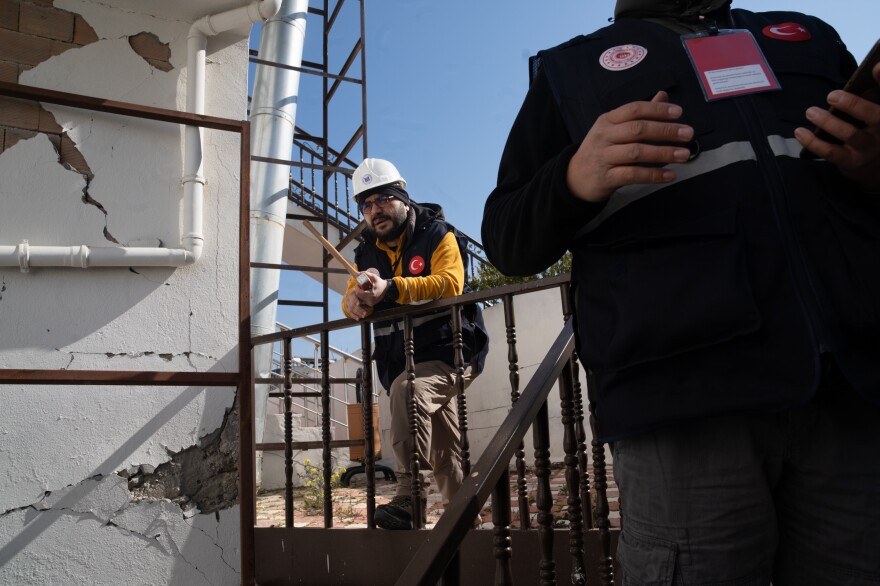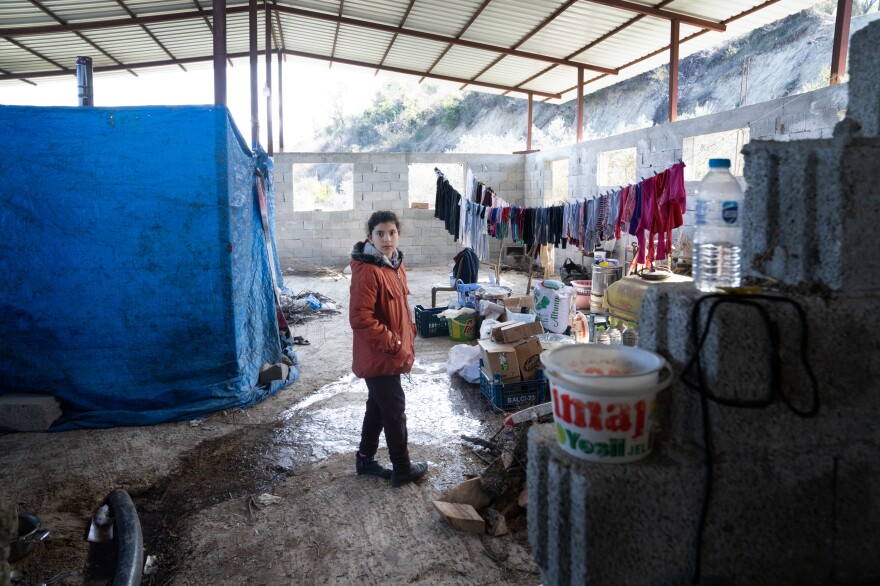SAMANDAG, Turkey — Yasin Pinarbasi usually works in an office in the Turkish capital Ankara. Now the civil engineer is clomping across unstable earthquake debris inside a four-story apartment building northeast of the city of Samandag.
From the outside the building appears to be in reasonably good condition, but once he enters there's a cinder block wall that has collapsed on the ground floor. Chunks of plaster and broken tile are strewn across the entryway.
"This building is highly damaged," Pinarbasi says. "It must be demolished."
This building, like many others in urban areas in Turkey, has shops at street level and apartments on the upper floors. Unlike many structures in the area, this one is still standing. The apartments appear from the outside to be intact. But Pinarbasi points out that several support pillars on the ground floor are cracked or completely severed where they connect to the beams above them.
"This is very typical [earthquake] damage on the columns, which we call unrepairable," he says.

The devastating 7.8 magnitude earthquake that struck Feb. 6 left more than 39,000 people dead and over a million homeless in Turkey alone, where tens of thousands of buildings were destroyed or badly damaged. More than 3,600 people died in neighboring Syria.
Now, hundreds of engineers are moving through wrecked areas of southern Turkey, as part of a process of seeing how safe the buildings are for people to be in them.
Pinarbasi volunteered as one of them, inspecting buildings and reporting initial damage assessments to the government, which he says has to make the final determination of what structures are inhabitable.
Cracked columns and beams
The buildings constructed over the last few decades largely have concrete columns and beams.
"In these kind of buildings, if one column or some of them are damaged like this one," he says, pointing up at the crumpled concrete where a column connects to the beam above it, "the loads are transferred to the other columns. Now they are overstressed." And that stress can make those remaining columns collapse. "These are dangerous," he says.


A national engineers association has assigned Pinarbasi to a zone on the road between Samandag and Antakya.
He has an app on his phone with every building in the zone marked on a map. The ones that haven't yet been inspected are white. Once a building has been checked, it shows up as green.
If a building has already collapsed, he enters "destroyed" in the app and moves on.
Anger over shoddy construction
The next building on his list is a restaurant with a large garden that serves as a wedding venue. "There are some cracks on the separating walls but not on the beams and columns," Pinarbasi says, as he and his colleague, Onur Tezcan Okut, survey the building.
This minor damage doesn't concern him. There can be cracks in non-load-bearing walls — some walls may have even collapsed entirely — and the building can still be deemed structurally sound. Pinarbasi is looking for whether there's damage to the columns or beams.

The engineers chip away some of the plaster to expose the beams underneath. Some of the windows of the restaurant are shattered. From the front, Pinarbasi says the building appears to have performed quite well structurally in the disaster.
But then they go to the back of the building and find a few thin cracks in support columns. Even worse, the concrete of the columns crumbles when they scratch at it with a hammer.
"It's probably poor quality concrete," Pinarbasi says.
He opens the app on his phone, uploads a couple of photos of the building and enters estimated square footage and year of construction. Then he classifies it as "moderately damaged."
Nationwide there's been outrage over buildings that collapsed in the disaster due to shoddy construction, sub-par materials and failure to comply with building codes. Some new apartment blocks, that were advertised as being built to the highest earthquake standards, crumpled in the earthquake.
In addition to tens of thousands of buildings that collapsed, Turkey's environment and urbanization minister says 50,000 more "need to be demolished urgently."
Petrified about going home
Up the hill from the restaurant, Pinarbasi and Okut move on to a gray four-story apartment building. It sits by itself on a hillside surrounded by olive trees. It's still intact. It has all its windows and there are no visible cracks in the facade.


When Pinarbasi knocks and tries the buzzers, no one answers. It turns out several of the residents are living in a barn behind the building.
Samir Kanar and three of his kids come out to talk to the engineers.
Kanar and his four brothers built the building in 2008. Kanar says he and his extended family were inside asleep when the earthquake hit, but none of them have slept inside it since. After the trauma of the disaster they're all afraid to go inside.
"It's been very hard emotionally," Kanar says to Pinarbasi as he leads him to the front door. "I have a 2 ½-year-old daughter and when she comes close to the house she starts crying."
More than a week after the quake, the apartments inside are in much the same condition as when the family ran out the morning of Feb. 6. Glass jars of preserved tomatoes are smashed across the kitchen floor. The refrigerator and cabinet doors are flung open and spilling their contents. Tables and even a wood stove are overturned.
But there are no cracks in the plaster walls. Pinarbasi says he doesn't see any structural damage to the building at all. Kanar, however, insists that if you stand out front, you can see that the building is now tilted. Pinarbasi disagrees, saying if it was leaning there would be evidence in its structural components, particularly at the corners. Kanar is not convinced but continues to walk through the building with Pinarbasi.


The resident's sister-in-law, Gonul Kanar, lived on the second floor. Her husband works in the Arabian Gulf so she was alone with her four children when the earthquake hit. She says she gathered all her children together and tried to lay on top of them to protect them as the room shook around them.
Now she says she doesn't ever want to return to her apartment. "I don't think that I will live here again," she says as tears well up in her eyes. "How can I get out of the building with four kids? Which one am I going to choose to pick up?"
The problem here is larger than structural engineering. It's about fear and anxiety and a lack of confidence in the way buildings have been constructed.
Gonul Kanar says she wants to build a small steel-frame house on the property, with just one story so she can live at ground level. She says she even would prefer living in a shipping container rather than go back into the apartment behind her.
Pinarbasi marks their building as not damaged in the app. With so many buildings damaged across the country, each engineer is trying to inspect 60 per day. He and his colleague, Okut, walk down the hill to the next one.
Samantha Balaban and Tuğba Öcek contributed to this story.
Copyright 2023 NPR. To see more, visit https://www.npr.org.








